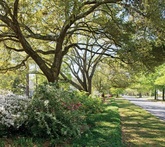 Click image to enlarge.
Click image to enlarge.
 Click image to enlarge. Click image to enlarge. Eufaula’s North Eufaula Avenue/US431 is lined with grand old homes and an impressive tree canopy that shades countless dogwoods, azaleas, and other flowering trees and shrubs. Every April it serves as “Main Street” for the Eufaula Pilgrimage, Alabama’s oldest and best known historic home tour. At that time, thousands enjoy the scenic drive past stately antebellum homes and newer structures of architectural and historical distinction. The mature streetscape (in the Seth Lore and Irwinton National Register Historic District) is unmatched for its distinctive combination of historic architecture and landscape features.
2 Comments
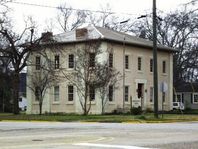 Click image to enlarge. Click image to enlarge. The Old Tuscaloosa County Jail is a handsome two-story brick building (with Georgian, Federal, Greek Revival, and Italianate features) that served as the county jail from 1856 to 1890. It sits vacant across the street from Tuscaloosa’s Capitol Park, near the site of urban redevelopment that is transforming downtown Tuscaloosa with new residential and retail construction. It has been vacant for five years and the owner, Tuscaloosa City School Board of Education, has no immediate plans for proactive preservation or restoration of the historic building. The historic structure is relatively weather-tight, but it is suffering from demolition by neglect, and the burgeoning value of nearby real estate could raise the risk of losing this rare public building that survives from Tuscaloosa’s early days. 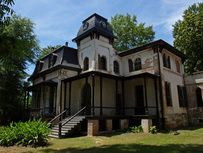 Click image to enlarge. Click image to enlarge. Winter Place consists of two large antebellum stuccoed brick dwellings and three smaller brick structures on a spacious corner lot in the Cottage Hill Historic District of Montgomery. The “North House” retains its original symmetrical fenestration and Italianate details, but the “South House” was renovated in the 1870s with a fashionable Mansard roof and tower and other Second Empire features. Few vintage buildings in either style survive in Montgomery. Winter Place is listed individually on the National Register because of its architectural significance, and it is listed as part of the locally designated Cottage Hill Historic District. 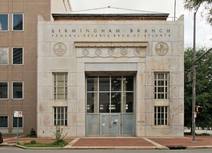 Click image to enlarge. Click image to enlarge. The Federal Reserve Bank of Atlanta, Birmingham Branch, is an early-twentieth-century neoclassical commercial structure with Art Deco influence by one of Alabama’s most renowned architectural firms. It sits in the heart of Birmingham’s banking and legal center. Although individually listed on the National Register of Historic Places, it has been vacant for several years and is now robbed of its original copper tiles and roofing. A redevelopment plan that capitalized on the 2014 Alabama Historic Rehabilitation Tax Credits lapsed in early April for lack of investors. Starwood Properties Trust, an out-of-state firm servicing the portfolio of a failed investment company, is entertaining a purchase proposal that would result in leveling the building for a parking lot. The Birmingham Design Review Board may be the next line of defense. Adaptive reuse, perhaps utilizing Alabama Historic Rehabilitation Tax Credits, is probably the most practical long-term preservation strategy to save this urban place in peril. 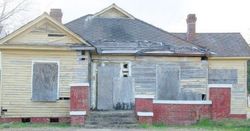 Click image to enlarge. Click image to enlarge. The tidy bungalow that was the home of stalwart Selma civil rights foot soldiers Amelia and Samuel Boynton is abandoned today. The Boyntons helped revive the Dallas County Voters League (DCVL) in the 1940s. In the two decades before Colia and Bernard Lafayette of the Student Non-Violent Coordinating Committee (SNCC) came to live with them in the 1960s, the Boyntons had been part of a small group that had begun to intensify efforts to increase black voter registration throughout the Black Belt. In 1964, the DCVL and SNCC along with Rev. F.D. Reese and other local leaders met in the Boynton House and issued an invitation to Dr. Martin Luther King Jr. of the Southern Christian Leadership Council (SCLC) to visit Selma in support of black voter registration. He arrived in January 1965 bringing national attention to the Voting Rights movement already underway. After being attacked on their first attempt, these activists along with thousands of others from all over the nation led a successful Selma to Montgomery March two months later, prompting President Lyndon Johnson and Congress to pass the Voting Rights Act of 1965. The seeds of that legislation and the subsequent transformation of American democracy were nurtured and took root in the Boynton House. |
Alabama's Endangered Historic LandmarksEach year since 1994, Alabama Heritage has highlighted threatened historic sites throughout Alabama. The “Places in Peril” list has identified more than 215 imperiled historic resources throughout the state, and is compiled by the Alabama Historical Commission and the Alabama Trust for Historic Preservation. The locations highlight the results of deferred maintenance, perceived obsolescence, development pressures, and lack of funding—forces that now more than ever threaten our cultural legacy. But awareness is a powerful force, too, and can cultivate a renewed determination to be responsible stewards of our heritage. For more information, visit the AHC or the ATHP websites. Alabama Heritage is proud to bring to you a selection of the places designated as perilous. Please keep your comments to information relevant to the featured place in peril. Alabama Heritage reserves the right to delete any comment that we deem inappropriate. Archives
May 2024
|
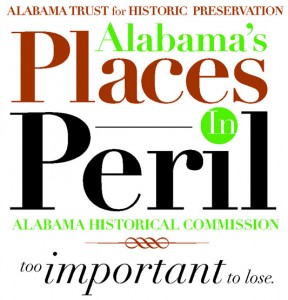
 RSS Feed
RSS Feed